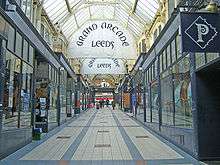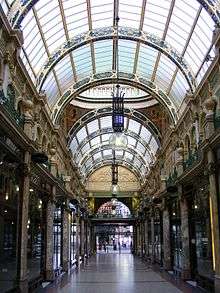Briggate, Leeds
Coordinates: 53°47′49″N 1°32′33″W / 53.7969°N 1.5424°W

Briggate is one of the pedestrianised principal shopping streets in central Leeds, England.
History
Early history
The name Briggate comes from brycg, the Old English word for bridge and gata, the Old Norse for a way or a street,[1] as it is the road leading north from Leeds Bridge, the oldest crossing point of the River Aire, and thus the main street of Leeds from its formation as a borough in 1207.[2] At this time the adjacent land was allocated into 30 burgage plots on each side for tradespeople to carry out their business, and this set both the style and layout of the street till today. They were also allocated half acre agricultural plots (tofts) in what is now known as Burmantofts (burgage men's tofts). The street slowly developed as the commercial centre, with fairs and markets being held by the end of the 13th century, just as the woollen industry was beginning the grow.[2] A Leeds annual fair was held on Briggate from 1322, and from 1341 there were two.[3]
16th century

In 1533, Leeds was described as "a praty market" consisting of little more than the four streets of Briggate, Kirkgate, Swinegate and Boar Lane, plus the "Head Rows".[3] Leeds' oldest building, a three-storey wooden house with a projecting upper storey is in Lambert's Yard, off Lower Briggate. It is late 16th or early 17th century.[4][5]
17th century
By the 17th Century, Briggate was lined with a mixture of shops, offices, workshops and houses, grand and humble, with the general area retaining its medieval street pattern,[2] but with the original burgage plots having been subdivided.[1] It was wide enough to allow regular open air markets.[3] At this time it finished in fields at what is now the Headrow, but a field path continued north. John Harrison was a wealthy cloth merchant and the King's Bailiff of Leeds, who owned land north of Briggate. He built himself a town house at the north end and extended the street as what is now called New Briggate, then New Street.[5] He also paid for a new Moot Hall and market cross by the market place on Briggate in 1615, and a grammar school on New Street in 1624. In addition he endowed the Church of St John which opened in 1634 to the west of his New Street.[2][5]
The Battle of Leeds took place principally along Briggate in 1643, during the English Civil War.[6]
18th century

In the 18th century, Briggate included a shambles or meat market and slaughter place described by Ralph Thoresby as "the best-furnished Flesh Shambles in the North of England". At the same time it had fine three-storey merchant's houses often with gardens and fields behind them.[3] A surviving example is Queens Court (1714), a former cloth merchant's house and business premises with packaging workshops and warehouses behind.[5] In this century, the population of Leeds grew substantially (from 6000 to 25000), though the area did not, leading to overcrowding. Many merchants moved their homes away from Briggate to areas such as Park Square leaving their properties to be subdivided and converted to commercial use or multiple residences.[3] This led to the lanes and yards off the street being filled in the 18th and 19th century with slum cottages and workplaces.[5]
19th century

In the early part of the 19th century Leeds was described as a "smokey city, dull and dirty", with Briggate being its "one large street". However in 1889, Briggate was described as "one of the broadest, handsomest, and busiest thoroughfares in the North of England",[7] Leeds' commercial success having led to the construction of many fine buildings, including the Grand Theatre on New Briggate in 1878. However, the fact that land on Briggate was owned in the medieval form of long strips from the street was particularly suitable for the construction of shopping arcades, beginning with Thornton's Arcade in 1878.[5] The Leeds Estate Company was formed to redevelop the area of the Shambles meat market, and surrounding slums. It was carried out from 1898 to 1904 under the direction of architect Frank Matcham, who created two new streets between Briggate and Vicar Lane: Queen Victoria Street and King Edward Street. The three blocks around them included the Empire Theatre and County Arcade and Cross Arcade.[5]
20th century
From the early 1900's trams ran up Briggate,[8] until the closure of Leeds tramways in 1959.[9] In 1907 a Post Office Exchange was built in brick and terracotta. It later became Woolworths who added an extra storey in 1920.[10] In 1909 Marks and Spencer opened their first store at number 75. A new building, the present store at number 47 was begun in 1939 but completed postwar in 1951.[5] In 1910, Dyson's Jewellers added a clock with a ball which dropped down at precisely 1 p.m. becoming a landmark known as the Time Ball buildings.[5] In the 1930s the Headrow became the main street of Leeds, with a decline in the fortunes of business in Briggate.[11] The department store Debenhams arrived in 1936 on the corner with Kirkgate with an unusual zigzag pattern of windows.[5] Developments often included the demolition of some old buildings,[11] including the Empire Theatre in the 1960s, to make very plain arcade.[5] The 1980s saw refurbishment of old buildings and the creation of Victoria Quarter in September 1990. This consists of three blocks between Briggate and Vicar Lane, comprising County Arcade, Cross Arcade, Queen Victoria Street and King Edward Street.[12] In the 1990s the arcade on the site of the Empire Theatre was itself demolished and a glazed frontage created to link the older buildings on either side which were refurbished in order to create a new Harvey Nichols store which opened in 1997.[5] Pedestrianisation started in 1993 when only buses were allowed to use it, and in 1996 it was closed to all traffic. However, Lower Briggate and New Briggate remain as public roads.
 Tramlines on Briggate around 1950
Tramlines on Briggate around 1950 A tram on Briggate, 1958
A tram on Briggate, 1958 Former 1907 Post Office Exchange
Former 1907 Post Office Exchange Time Ball buildings, Lower Briggate
Time Ball buildings, Lower Briggate Debenhams, with Kirkate to the right
Debenhams, with Kirkate to the right Marks and Spencer 1951 building
Marks and Spencer 1951 building Victoria Quarter entrance
Victoria Quarter entrance Harvey Nichols, main entrance
Harvey Nichols, main entrance
21st century
In phases from 2004 to 2006, Briggate was paved with York Stone, removing the roadway and pavements that remained. In 2008 the 1970s Burton Arcade at the southern end of Briggate was demolished to make way for the Trinity Quarter. It opened in March 2013. In 2008 the Market Street Arcade which faced the Burton Arcade at the southern end of Briggate closed to make way for a redeveloped arcade with an extra level, glass roof and new tenants. It reopened in 2012 as the Central Arcade with a first floor and is extensively glazed.[13]
Arcades
Leeds is noted for the arcades on either side of Briggate. Modern arcades were built in the 1970s at the southern end, but the arcades of architectural significance are at its northern end.
- Grand Arcade was built by the New Briggate Arcade Company Ltd in 1897, with Smith & Tweedal as architects. It is home to small, independent retailers on the non-pedestrianised New Briggate.
- Thorntons Arcade, designed by Charles Fowler a Leeds architect, was completed in May 1878. William Potts and Son designed and made a clock with four life size figures that stands above the western exit onto Lands Lane.
- Queens Arcade, named after the reigning monarch was opened in 1889. The Briggate entrance was enlarged in 1895. It is particularly light and airy, and tenants are largely designer or upper-class novelty shops similar to those found on London's Carnaby Street.
- County Arcade designed by architect Frank Matcham was completed in 1903 and is particularly grand when compared to the other arcades. Its marble floors, intricate stonework and elegant iron domes make up part of the Victoria Quarter complex.
- Queen Victoria Street has been arcaded since 1990. The largest expanse of stained glass in Europe, designed by Brian Clark, makes up its impressive canopy. It is part of the Victoria Quarter and linked to County Arcade by Cross Arcade which is of the same design as County Arcade.
- Central Arcade opened in 2012 on the former Market Street Arcade site. This is the only arcade to have shops on the first floor.
 Grand Arcade
Grand Arcade Thornton's showing the clock
Thornton's showing the clock.jpg) Queens Arcade
Queens Arcade County Arcade
County Arcade Cross Arcade
Cross Arcade Central Arcade
Central Arcade
Theatres
- Leeds Grand Theatre on New Briggate was redeveloped from 2004 to provide an enlarged home for Opera North and regenerate the area.
- Leeds City Varieties on Swan Street is one of the UK's oldest music halls.[14] The City Varieties was granted Heritage Lottery funding for refurbishment and restoration,[15] and closed in January 2009 and re-opened in September 2011.
- Frank Matcham's Empire Theatre on Briggate was demolished in the 1960s, its site is occupied by Harvey Nichols.
Yards
Briggate is known for its yards or alleyways that branch off and have changed little over the years. They house public houses such as Whitelocks, The Ship, The Packhorse and The Angel Inn. The back entrances to the yards were called 'low ins', or 'loins', which is where the term Loiner (a resident of Leeds) is suspected to originate. Loiner refers to the people who would 'hang around in the loins'.[16][17]
References
- 1 2 "Discovering Leeds>Briggate>Origins". www.leodis.net. Leeds City Council. 2003. Retrieved 8 September 2018.
- 1 2 3 4 Barker, Paul (2010). Leeds. London: Frances Lincoln Ltd. p. 10,13, 16. ISBN 9780 7112 29204.
- 1 2 3 4 5 Mitchell, W. R. (2000). A History of Leeds. Chichester: Phillimore. p. 28, 43-45, 31. ISBN 1 86077 130 0.
- ↑ Historic England. "Lambert's Arcade (1375066)". National Heritage List for England. Retrieved 11 October 2018.
- 1 2 3 4 5 6 7 8 9 10 11 12 Wrathmell, Susan (2005). Pevsner Architectural Guides: Leeds. Yale University Press. p. 10, 25-6, 90-101, 156-161. ISBN 0-300-10736-6.
- ↑ "Leeds nostalgia: Street at heart of the city". Yorkshire Evening Post. 23 February 2015. Retrieved 10 September 2018.
- ↑ Broadhead, Ivan (1990). Leeds. Otley: Smith Settle. p. 23-25,29. ISBN 1870071638.
- ↑ "Memories by the tram load". Yorkshire Evening Post. 19 April 2003. Retrieved 10 September 2018.
- ↑ "Electric Tramways of Yorkshire". www.lrta.org. Light Rail Transit Association. Retrieved 10 September 2018.
- ↑ Historic England. "133, 135 and 137, Briggate (1255830)". National Heritage List for England. Retrieved 7 October 2018.
- 1 2 "Discovering Leeds>Briggate>Development". www.leodis.net. Leeds City Council. 2003. Retrieved 8 September 2018.
- ↑ "Leeds: Celebrating 20 years at Victoria Quarter". Yorkshire Evening Post. 9 September 2010. Retrieved 25 June 2018.
- ↑ "Central Arcade". Central Arcade. Retrieved 29 October 2016.
- ↑ "Archived copy". Archived from the original on 5 October 2008. Retrieved 2 August 2008.
- ↑ "Archived copy". Archived from the original on 25 October 2007. Retrieved 31 May 2013.
- ↑ "Archived copy". Archived from the original on 3 October 2008. Retrieved 2 August 2008.
- ↑ "Leeds - voices2005 - Loiners of the world unite!". BBC. Retrieved 29 October 2016.
External links
| Wikimedia Commons has media related to Briggate. |